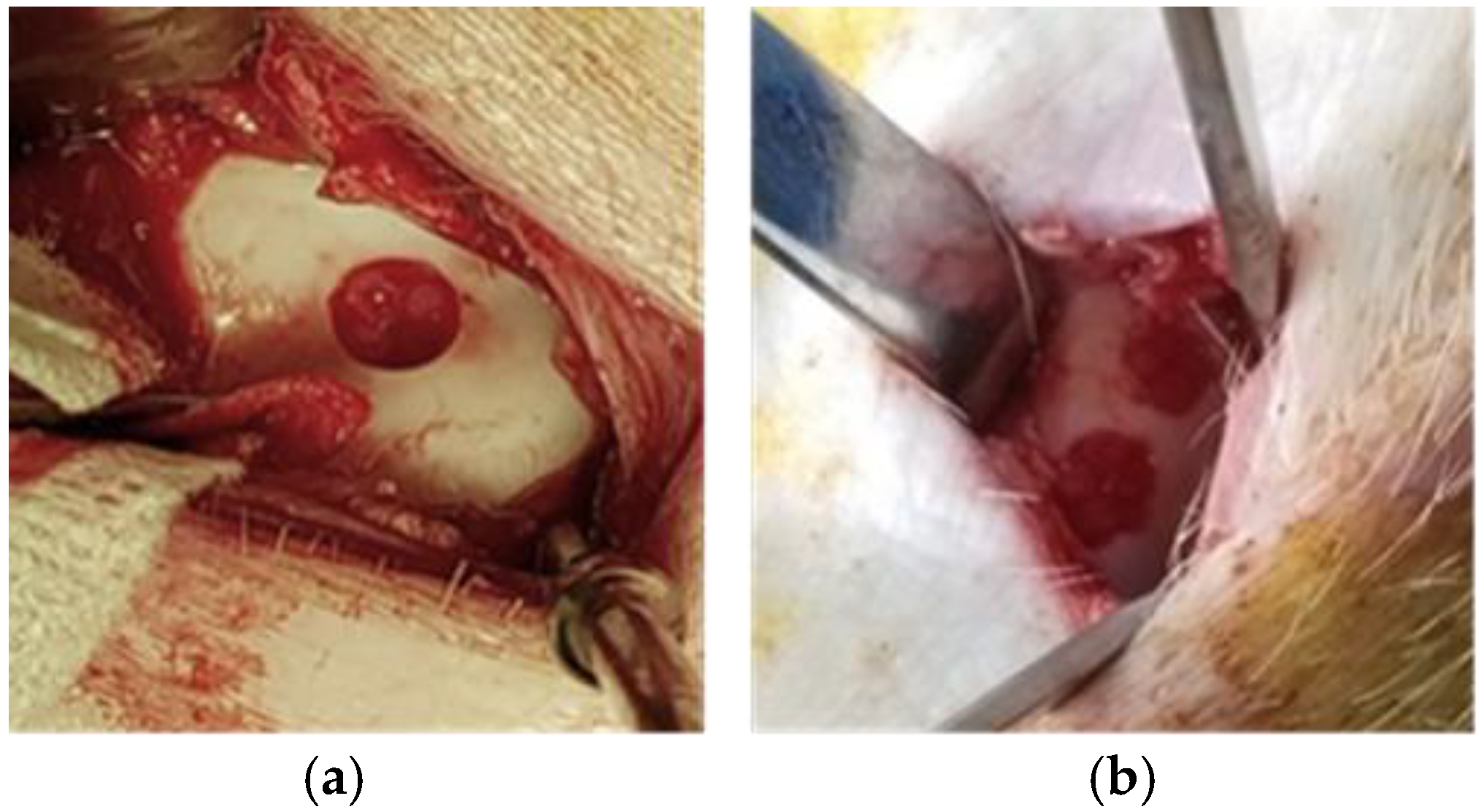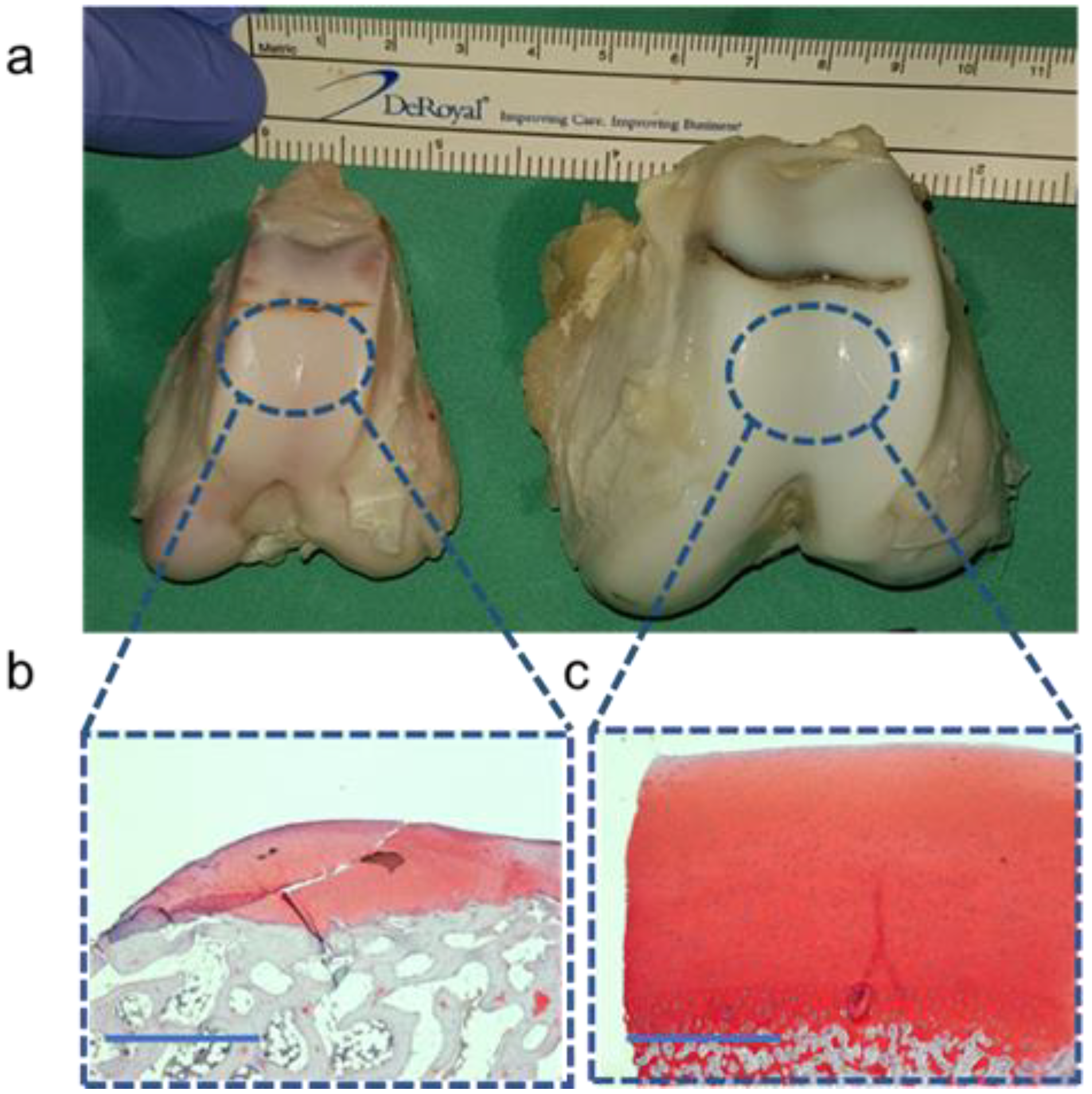The Mini-Pig as an Animal Model for Focal Cartilage Treatment of the Knee—A Comparison to the Domestic Pig
Abstract
:1. Introduction
2. Materials and Methods
2.1. Animals
2.2. Anesthesia
2.3. Surgeries
2.4. Postoperative Protocol
2.5. Euthanasia and Descriptive Analysis
2.6. Contralateral Knee Comparison
2.7. G-MP and DP Comparison
2.8. Graphical Generation
3. Results
3.1. Anatomy and Surgical Approaches
3.2. Complications And Morbidity
3.3. Comparison
4. Discussion
5. Conclusions
Supplementary Materials
Author Contributions
Funding
Institutional Review Board Statement
Informed Consent Statement
Data Availability Statement
Acknowledgments
Conflicts of Interest
References
- Belk, J.W.; McCarty, E. Editorial Commentary: Autologous Chondrocyte Implantation Versus Microfracture for Knee Articular Cartilage Repair: We Should Focus on the Latest Autologous Chondrocyte Implantation Techniques. Arthrosc. J. Arthrosc. Relat. Surg. 2020, 36, 304–306. [Google Scholar] [CrossRef]
- Hoburg, A.; Niemeyer, P.; Laute, V.; Zinser, W.; Becher, C.; Kolombe, T.; Fay, J.; Pietsch, S.; Kuźma, T.; Widuchowski, W.; et al. Matrix-Associated Autologous Chondrocyte Implantation with Spheroid Technology Is Superior to Arthroscopic Microfracture at 36 Months Regarding Activities of Daily Living and Sporting Activities after Treatment. CARTILAGE 2021, 13, 194760351989729. [Google Scholar] [CrossRef]
- Riboh, J.C.; Cvetanovich, G.L.; Cole, B.J.; Yanke, A.B. Comparative efficacy of cartilage repair procedures in the knee: A network meta-analysis. Knee Surg. Sports Traumatol. Arthrosc. 2017, 25, 3786–3799. [Google Scholar] [CrossRef] [PubMed]
- Moran, C.J.; Ramesh, A.; Brama, P.A.J.; O’Byrne, J.M.; O’Brien, F.J.; Levingstone, T.J. The benefits and limitations of animal models for translational research in cartilage repair. J. Exp. Orthop. 2016, 3, 1. [Google Scholar] [CrossRef]
- Allen, M.J.; Hankenson, K.D.; Goodrich, L.; Boivin, G.P.; von Rechenberg, B. Ethical use of animal models in musculoskeletal research. J. Orthop. Res. 2017, 35, 740–751. [Google Scholar] [CrossRef]
- Gutierrez, K.; Dicks, N.; Glanzner, W.G.; Agellon, L.B.; Bordignon, V. Efficacy of the porcine species in biomedical research. Front. Genet. 2015, 6, 293. [Google Scholar] [CrossRef]
- Lu, Z.; Liu, Q.; Liu, L.; Wu, H.; Zheng, L.; Zhao, J. A Novel Synthesized Sulfonamido-Based Gallate-JEZTC Blocks Cartilage Degradation on Rabbit Model of Osteoarthritis: An in Vitro and in Vivo Study. Cell. Physiol. Biochem. 2018, 49, 2304–2319. [Google Scholar] [CrossRef]
- McIlwraith, C.W.; Fortier, L.A.; Frisbie, D.D.; Nixon, A.J. Equine Models of Articular Cartilage Repair. CARTILAGE 2011, 2, 317–326. [Google Scholar] [CrossRef]
- Pfeifer, C.G.; Fisher, M.B.; Saxena, V.; Kim, M.; Henning, E.A.; Steinberg, D.A.; Dodge, G.R.; Mauck, R.L. Age-Dependent Subchondral Bone Remodeling and Cartilage Repair in a Minipig Defect Model. Tissue Eng. Part C: Methods 2017, 23, 745–753. [Google Scholar] [CrossRef]
- Xia, D.; Jin, D.; Wang, Q.; Gao, M.; Zhang, J.; Zhang, H.; Bai, J.; Feng, B.; Chen, M.; Huang, Y.; et al. Tissue-engineered trachea from a 3D-printed scaffold enhances whole-segment tracheal repair in a goat model. J. Tissue Eng. Regen. Med. 2019, 13, 694–703. [Google Scholar] [CrossRef]
- Bekkers, J.E.J.; Creemers, L.B.; Tsuchida, A.I.; van Rijen, M.H.P.; Custers, R.J.H.; Dhert, W.J.A.; Saris, D.B.F. One-stage focal cartilage defect treatment with bone marrow mononuclear cells and chondrocytes leads to better macroscopic cartilage regeneration compared to microfracture in goats. Osteoarthr. Cartil. 2013, 21, 950–956. [Google Scholar] [CrossRef]
- Cone, S.G.; Warren, P.B.; Fisher, M.B. Rise of the Pigs: Utilization of the Porcine Model to Study Musculoskeletal Biomechanics and Tissue Engineering During Skeletal Growth. Tissue Eng. Part C Methods 2017, 23, 763–780. [Google Scholar] [CrossRef]
- Hsieh, Y.-H.; Shen, B.-Y.; Wang, Y.-H.; Lin, B.; Lee, H.-M.; Hsieh, M.-F. Healing of Osteochondral Defects Implanted with Biomimetic Scaffolds of Poly(ε-Caprolactone)/Hydroxyapatite and Glycidyl-Methacrylate-Modified Hyaluronic Acid in a Minipig. Int. J. Mol. Sci. 2018, 19, 1125. [Google Scholar] [CrossRef] [PubMed]
- Rieppo, J.; Hyttinen, M.M.; Halmesmaki, E.; Ruotsalainen, H.; Vasara, A.; Kiviranta, I.; Jurvelin, J.S.; Helminen, H.J. Changes in spatial collagen content and collagen network architecture in porcine articular cartilage during growth and maturation. Osteoarthr. Cartil. 2009, 17, 448–455. [Google Scholar] [CrossRef]
- Ganderup, N.C.; Harvey, W.; Mortensen, J.T.; Harrouk, W. The Minipig as Nonrodent Species in Toxicology—Where Are We Now? Int. J. Toxicol. 2012, 31, 507–528. [Google Scholar] [CrossRef]
- Kang, Q.; LaBreck, J.; Gruber, H.; An, Y. Histological Techniques for Decalcified Bone and Cartilage. In Handbook of Histology Methods for Bone and Cartilage; Springer: Berlin/Heidelberg, Germany, 2003; pp. 209–219. ISBN 978-1-61737-277-3. [Google Scholar]
- Schmitz, N.; Laverty, S.; Kraus, V.B.; Aigner, T. Basic methods in histopathology of joint tissues. Osteoarthr. Cartil. 2010, 18, S113–S116. [Google Scholar] [CrossRef]
- Christensen, B.B.; Foldager, C.B.; Olesen, M.L.; Vingtoft, L.; Rölfing, J.H.D.; Ringgaard, S.; Lind, M. Experimental articular cartilage repair in the Göttingen minipig: The influence of multiple defects per knee. J. Exp. Orthop. 2015, 2, 13. [Google Scholar] [CrossRef]
- Kutaish, H.; Tscholl, P.M.; Cosset, E.; Bengtsson, L.; Braunersreuther, V.; Mor, F.M.; Laedermann, J.; Furfaro, I.; Stafylakis, D.; Hannouche, D.; et al. Articular Cartilage Repair After Implantation of Hyaline Cartilage Beads Engineered from Adult Dedifferentiated Chondrocytes: Cartibeads Preclinical Efficacy Study in a Large Animal Model. Am. J. Sports Med. 2023, 51, 237–249. [Google Scholar] [CrossRef]
- Guo, X.; Park, H.; Young, S.; Kretlow, J.D.; Van den Beucken, J.J.; Baggett, L.S.; Tabata, Y.; Kasper, F.K.; Mikos, A.G.; Jansen, J.A. Repair of osteochondral defects with biodegradable hydrogel composites encapsulating marrow mesenchymal stem cells in a rabbit model. Acta Biomater. 2010, 6, 39–47. [Google Scholar]
- Schafrum Macedo, A.; Cezaretti Feitosa, C.; Yoiti Kitamura Kawamoto, F.; Vinicius Tertuliano Marinho, P.; dos Santos Dal-Bó, Í.; Fiuza Monteiro, B.; Prado, L.; Bregadioli, T.; Antonio Covino Diamante, G.; Ricardo Auada Ferrigno, C. Animal modeling in bone research—Should we follow the White Rabbit? Anim. Models Exp. Med. 2019, 2, 162–168. [Google Scholar] [CrossRef]
- Franklin, S.P.; Stoker, A.M.; Lin, A.S.P.; Pownder, S.L.; Burke, E.E.; Bozynski, C.C.; Kuroki, K.; Guldberg, R.E.; Cook, J.L.; Holmes, S.P. T1ρ, T2 mapping, and EPIC-µCT Imaging in a Canine Model of Knee Osteochondral Injury. J. Orthop. Res. 2020, 38, 368–377. [Google Scholar] [CrossRef] [PubMed]
- Canonici, F.; Cocumelli, C.; Cersini, A.; Marcoccia, D.; Zepparoni, A.; Altigeri, A.; Caciolo, D.; Roncoroni, C.; Monteleone, V.; Innocenzi, E.; et al. Articular Cartilage Regeneration by Hyaline Chondrocytes: A Case Study in Equine Model and Outcomes. Biomedicines 2023, 11, 1602. [Google Scholar] [CrossRef] [PubMed]


 Red star shows the harvest site.
Red star shows the harvest site.
 Red star shows the harvest site.
Red star shows the harvest site.


| Number of Animals | Göttingen-Mini-Pig | Domestic Pig |
|---|---|---|
| n = 6 | n = 4 | |
| Age at first surgery (month) | 17 | 5 |
| Weight at start kg (SD) | 45 (±5) | 50 (±3) |
| Side | right | right |
| Visual field: superolateral approach (%) | trochlea 11 (±5) | trochlea 20 (±3) |
| Visual field: medial parapatellar approach % (SD) | trochlea 60 (±5) condyle 50 (±10) | trochlea 63 (±4) condyle 34 (±13) |
| Trochlear width mm (SD) | 14 (±2) | 25 (±5) |
| Trochlear length lateral mm (SD) | 28 (±2) | 42 (±3) |
| Trochlear length medial mm (SD) | 33 (±1) | 40 (±1) |
| Cartilage thickness (mm) * | 0.8–1 | >2 |
| Potential harvest mg (SD) ** | 40 (±20) | 160 (±40) |
| Number of Animals | Göttingen Mini-Pig | Domestic Pig |
|---|---|---|
| n = 6 | n = 4 | |
| Range of motion * | Comparable | Comparable |
| Joint morphology * | Comparable | Comparable |
| Cartilage degeneration † | 0 | 0 |
| Hoffa fat pad fibrosis | 0 | 0 |
| Patellar tendon shortening * (%) | 0 | 0 |
| Conflict donor site: graft site | Yes 2/6 | No 0/4 |
Disclaimer/Publisher’s Note: The statements, opinions and data contained in all publications are solely those of the individual author(s) and contributor(s) and not of MDPI and/or the editor(s). MDPI and/or the editor(s) disclaim responsibility for any injury to people or property resulting from any ideas, methods, instructions or products referred to in the content. |
© 2025 by the authors. Licensee MDPI, Basel, Switzerland. This article is an open access article distributed under the terms and conditions of the Creative Commons Attribution (CC BY) license (https://creativecommons.org/licenses/by/4.0/).
Share and Cite
Kutaish, H.; Tieng, V.; Tscholl, P.M. The Mini-Pig as an Animal Model for Focal Cartilage Treatment of the Knee—A Comparison to the Domestic Pig. Surg. Tech. Dev. 2025, 14, 9. https://doi.org/10.3390/std14020009
Kutaish H, Tieng V, Tscholl PM. The Mini-Pig as an Animal Model for Focal Cartilage Treatment of the Knee—A Comparison to the Domestic Pig. Surgical Techniques Development. 2025; 14(2):9. https://doi.org/10.3390/std14020009
Chicago/Turabian StyleKutaish, Halah, Vannary Tieng, and Philippe Matthias Tscholl. 2025. "The Mini-Pig as an Animal Model for Focal Cartilage Treatment of the Knee—A Comparison to the Domestic Pig" Surgical Techniques Development 14, no. 2: 9. https://doi.org/10.3390/std14020009
APA StyleKutaish, H., Tieng, V., & Tscholl, P. M. (2025). The Mini-Pig as an Animal Model for Focal Cartilage Treatment of the Knee—A Comparison to the Domestic Pig. Surgical Techniques Development, 14(2), 9. https://doi.org/10.3390/std14020009






